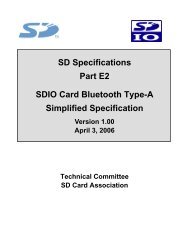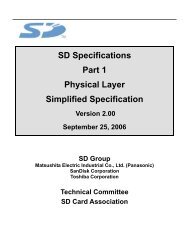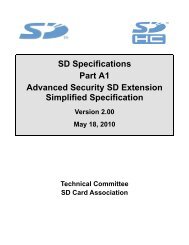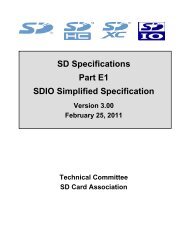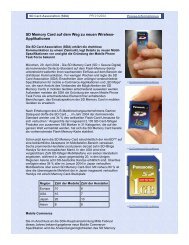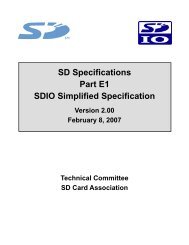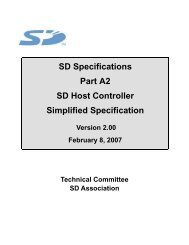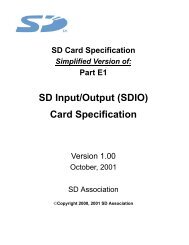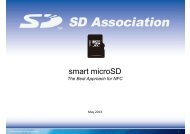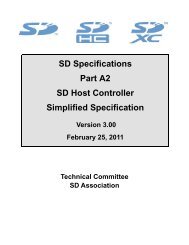SD Specifications Part 1 UHS-II Simplified Addendum - SD Association
SD Specifications Part 1 UHS-II Simplified Addendum - SD Association
SD Specifications Part 1 UHS-II Simplified Addendum - SD Association
You also want an ePaper? Increase the reach of your titles
YUMPU automatically turns print PDFs into web optimized ePapers that Google loves.
<strong>UHS</strong>-<strong>II</strong> <strong>Simplified</strong> <strong>Addendum</strong> Version 1.01©Copyright 2010-2013 <strong>SD</strong> Card <strong>Association</strong>6. Transaction Layer SpecificationThe details of <strong>UHS</strong>-<strong>II</strong> protocol including packet format, Configuration, state machine, initialization andflow control are described in this chapter.6.1 Transaction Layer OverviewFigure 6-1 shows the overview of Transaction Layer.TransactionApplicationspecific layerCM-TRAN(Common layer)<strong>SD</strong>-TRAN(<strong>SD</strong> specific)Tran ManagementTPSMTBSMTSSM<strong>SD</strong> CMD/RES/DAT<strong>SD</strong> Card Register<strong>SD</strong> State MachineProtocol Bridge (<strong>SD</strong>CM)Transactions (Data, Control)EnumerationConfigurationCommon Packets (DCMD, CCMD, RES, DATA)**-TRAN(extensible TRAN for future use)Extended <strong>Part</strong>CMD QueuingRelaxed OrderingID based Mux/DemuxFigure 6-1 : Transaction Layer OverviewThe key features of Transaction Layer are defined as follows: New packet based protocol considering Legacy <strong>SD</strong> compatibility ID based routing for multiple device connectivity CM-TRAN for common architecture between Host and DeviceTransaction Layer consists of two sub-layers called CM-TRAN (lower sub-layer) and application specificlayer including <strong>SD</strong>-TRAN (upper sub-layer). This layering is intended to define the common part ofTRAN (CM-TRAN) between Host and Device. As a result, the same CM-TRAN can be used in bothHost and Device side.CM-TRAN provides basic functions to realize transactions on <strong>UHS</strong>-<strong>II</strong> native protocol.CM-TRAN components are the following; Generating <strong>UHS</strong>-<strong>II</strong> common packets and processing Configuration mechanism Transaction management supporting multiple device connection Future extension support (e.g. CMD Queuing)CM-TRAN is also defined to be the common sub-layer between all application specific layers in order torealize <strong>UHS</strong>-<strong>II</strong> specific functions (e.g. multiple device connection, CMD Queuing, etc.) with applicationspecific protocol.For example, in Figure 6-1, CM-TRAN can provide <strong>SD</strong> protocol with a CMD Queuing feature as a futureextension.<strong>SD</strong>-TRAN is an application specific layer for compatibility with <strong>SD</strong> protocol and preserves the samestate machine and registers as Legacy <strong>SD</strong> protocol. <strong>SD</strong>-TRAN works as a protocol bridging betweenLegacy <strong>SD</strong> and <strong>UHS</strong>-<strong>II</strong> native protocol. (Refer to Chapter 7 for details of <strong>SD</strong>-TRAN.)40



